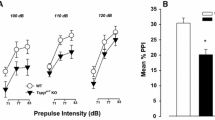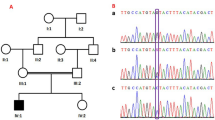Abstract
Snyder–Robinson syndrome (SRS) is a form of X-linked mental retardation resulting from mutations in spermine synthase (SMS), which impact neurodevelopment and cognitive outcome. We obtained cerebral, cerebellum, hippocampus, and red nucleus volumes from two males with SRS and 24 age- and gender-matched typically developing controls using volumetric neuroimaging analyses. Total brain volume was enlarged in males with SRS while cerebellum, hippocampus, and red nucleus volumes tended to be reduced compared to controls. Mutations of the X chromosome may modulate the risk for mental retardation through altered early neurodevelopment, disruption in receptor function, and ongoing neural organization and plasticity. Disruption of SMS function may negatively affect regional brain volumes that subserve cognitive and motor abilities. This research provides valuable insight into the effects of polyamine function on brain development.


Similar content being viewed by others
Explore related subjects
Discover the latest articles and news from researchers in related subjects, suggested using machine learning.References
Snyder RD, Robinson A (1969) Recessive sex-linked mental retardation in the absence of other recognizable abnormalities. Report of a family. Clin Pediatr 8(11):669–674. doi:10.1177/000992286900801114
Arena JF, Schwartz C, Ouzts L, Stevenson R, Miller M, Garza J, Nance M, Lubs H (1996) X-linked mental retardation with thin habitus, osteoporosis, and kyphoscoliosis: linkage to Xp21.3-p22.12. Am J Med Genet 64(1):50–58. doi:10.1002/(SICI)1096-8628(19960712)64:1<50::AID-AJMG7>3.0.CO;2-V
Cason AL, Ikeguchi Y, Skinner C, Wood TC, Holden KR, Lubs HA, Martinez F, Simensen RJ, Stevenson RE, Pegg AE, Schwartz CE (2003) X-linked spermine synthase gene (SMS) defect: the first polyamine deficiency syndrome. Eur J Hum Genet 11(12):937–944. doi:10.1038/sj.ejhg.5201072
de Alencastro G, McCloskey DE, Kliemann SE, Maranduba CM, Pegg AE, Wang X, Bertola DR, Schwartz CE, Passos-Bueno MR, Sertie AL (2008) New SMS mutation leads to a striking reduction in spermine synthase protein function and a severe form of Snyder-Robinson X-linked recessive mental retardation syndrome. J Med Genet 45(8):539–543. doi:10.1136/jmg.2007.056713
Janne J, Alhonen L, Pietila M, Keinanen TA (2004) Genetic approaches to the cellular functions of polyamines in mammals. Eur J Biochem 271(5):877–894. doi:10.1111/j.1432-1033.2004.04009.x
Shalin SC, Egli R, Birnbaum SG, Roth TL, Levenson JM, Sweatt JD (2006) Signal transduction mechanisms in memory disorders. Prog Brain Res 157:25–41. doi:10.1016/S0079-6123(06) 57003-7
Kates WR, Warsofsky IS, Patwardhan A, Abrams MT, Liu AM, Naidu S, Kaufmann WE, Reiss AL (1999) Automated Talairach atlas-based parcellation and measurement of cerebral lobes in children. Psychiatry Res 91(1):11–30. doi:10.1016/S0925-4927(99) 00011-6
Reiss AL, Hennessey JG, Rubin M, Beach L, Abrams MT, Warsofsky IS, Liu AM, Links JM (1998) Reliability and validity of an algorithm for fuzzy tissue segmentation of MRI. J Comput Assist Tomogr 22(3):471–479. doi:10.1097/00004728-199805000-00021
Kates WR, Abrams MT, Kaufmann WE, Breiter SN, Reiss AL (1997) Reliability and validity of MRI measurement of the amygdala and hippocampus in children with fragile X syndrome. Psychiatry Res 75(1):31–48. doi:10.1016/S0925-4927(97) 00019-X
Spiegel M, Schiller J, Srinivasan R (2000) Schaum's Outline of Probability and Statistics. McGraw-Hill, New York
Tukey J (1977) Exploratory data analysis. Addison-Wesley, Reading
Ge Y, Grossman RI, Babb JS, Rabin ML, Mannon LJ, Kolson DL (2002) Age-related total gray matter and white matter changes in normal adult brain. Part I: volumetric MR imaging analysis. AJNR Am J Neuroradio 23(8):1327–1333
Marton LJ, Pegg AE (1995) Polyamines as targets for therapeutic intervention. Annu Rev Pharmacol Toxicol 35:55–91. doi:10.1146/annurev.pa.35.040195.000415
Clarkson AN, Liu H, Pearson L, Kapoor M, Harrison JC, Sammut IA, Jackson DM, Appleton I (2004) Neuroprotective effects of spermine following hypoxic-ischemic-induced brain damage: a mechanistic study. FASEB J 18(10):1114–1116
Gilad GM, Gilad VH (1999) Novel polyamine derivatives as neuroprotective agents. J Pharmacol Exp Ther 291(1):39–43
Yatin SM, Yatin M, Varadarajan S, Ain KB, Butterfield DA (2001) Role of spermine in amyloid beta-peptide-associated free radical-induced neurotoxicity. J Neurosci Res 63(5):395–401. doi:10.1002/1097-4547(20010301) 63:5<395::AID-JNR1034>3.0.CO;2-Q
Mostofsky SH, Mazzocco MM, Aakalu G, Warsofsky IS, Denckla MB, Reiss AL (1998) Decreased cerebellar posterior vermis size in fragile X syndrome: correlation with neurocognitive performance. Neurology 50(1):121–130
Schmahmann JD (2004) Disorders of the cerebellum: ataxia, dysmetria of thought, and the cerebellar cognitive affective syndrome. J Neuropsychiatry Clin Neurosci 16(3):367–378. doi:10.1176/appi.neuropsych.16.3.367
Kurata HT, Marton LJ, Nichols CG (2006) The polyamine binding site in inward rectifier K + channels. J Gen Physiol 127(5):467–480. doi:10.1085/jgp. 200509467
Reimann F, Ashcroft FM (1999) Inwardly rectifying potassium channels. Curr Opin Cell Biol 11(4):503–508. doi:10.1016/S0955-0674(99) 80073-8
Best TK, Siarey RJ, Galdzicki Z (2007) Ts65Dn, a mouse model of Down syndrome, exhibits increased GABAB-induced potassium current. J Neurophysiol 97(1):892–900. doi:10.1152/jn.00626.2006
Turecek R, Vlcek K, Petrovic M, Horak M, Vlachova V, Vyklicky L (2004) Intracellular spermine decreases open probability of N-methyl-D-aspartate receptor channels. Neuroscience 125(4):879–887. doi:10.1016/j.neuroscience.2004.03.003
Harney SC, Rowan M, Anwyl R (2006) Long-term depression of NMDA receptor-mediated synaptic transmission is dependent on activation of metabotropic glutamate receptors and is altered to long-term potentiation by low intracellular calcium buffering. J Neurosci 26(4):1128–1132
Ingi T, Worley PF, Lanahan AA (2001) Regulation of SSAT expression by synaptic activity. Eur J Neurosci 13(7):1459–1463. doi:10.1046/j.0953-816x.2001.01529.x
Shin J, Shen F, Huguenard JR (2005) Polyamines modulate AMPA receptor-dependent synaptic responses in immature layer v pyramidal neurons. J Neurophysiol 93(5):2634–2643. doi:10.1152/jn.01054.2004
Williams K (1997) Interactions of polyamines with ion channels. Biochem J 325(Pt 2):289–297
Morrison LD, Kish SJ (1995) Brain polyamine levels are altered in Alzheimer's disease. Neurosci Lett 197(1):5–8. doi:10.1016/0304-3940(95) 11881-V
Acknowledgements
This research was supported by NIH grant HD 26202. The authors would like to acknowledge Dr. Booil Jo for her assistance with statistical methods.
Author information
Authors and Affiliations
Corresponding author
Electronic Supplementary Material
Below is the link to the electronic supplementary material.
Supplementary Figure 1
Whole Brain Volumes Measurement: a Gray scale brain image (left) is separated into gray matter, white matter and CSF tissues, left to right, respectively, using a constrained fuzzy segmentation algorithm. Voxel shade represents the proportion of the specific tissue at that location (darker = increased). b Gray matter images are shown in multiplanar views in BrainImage. The Talairach stereotaxic grid (shown by dotted and solid lines) is used for positional normalization and parcellation of brain tissue into subregions. The Talairach sectors corresponding to the frontal lobe are outlined in solid lines. (PDF 1017 kb)
Supplementary Figure 2
Red Nucleus Volume Measurement. The anterior/posterior range of the red nucleus was defined in reference to the posterior commissure: drawn on the fourth through the sixth axial slices from posterior commissure. The superior boundary was the white matter bordering the thalamus (occasionally absent, in which case the rater used the thalamus itself). The substantia nigra formed the inferior boundary. The medial boundary consisted of a vertical line between the interpeduncular cistern and third ventricle, separating the two cerebral hemispheres. The lateral boundary was formed by the cerebral peduncle white matter tract, avoiding the darker gray matter of the subthalamic nuclei in posterior slices. (PDF 1017 kb)
Rights and permissions
About this article
Cite this article
Kesler, S.R., Schwartz, C., Stevenson, R.E. et al. The impact of spermine synthase (SMS) mutations on brain morphology. Neurogenetics 10, 299–305 (2009). https://doi.org/10.1007/s10048-009-0184-2
Received:
Accepted:
Published:
Issue Date:
DOI: https://doi.org/10.1007/s10048-009-0184-2




